Ways of the Upward and Downward Spirals
David M. Boje
And that is why, all these downward small business spirals, I now stress the virtues.
There are other vices and virtues and intermediate pathways through the Virtue Spiral. These you must find in each small business. It is important that the class begins with a study of ethics, since the unethical small business will ultimately fail, and not serve the common good (happiness). One role model of not only virtue but several other types of ethics is Bill Daniels.
Question 1: What are the major types of Ethics used by Bill Daniels and give two examples from his life story? Short Answer, virtue, instrumental, answerability, and rule-based. For the examples, read on.
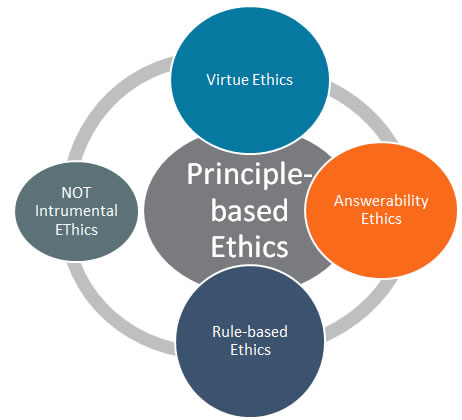
Figure 25: Basic Types of Ethics related to Principle-Based Ethics - copyright Chapter on ethics in Quantum Storytelling BOOK by D. Boje
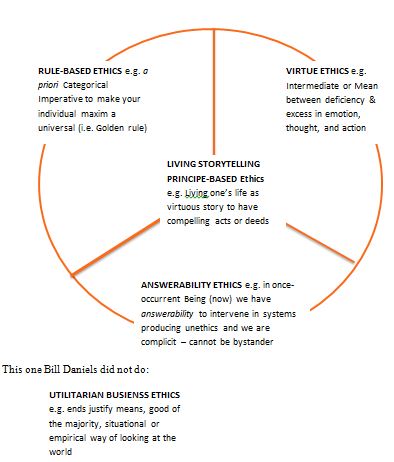
Figure 26 - Defining Types of Ethics Related or Not to Bill Daniels - copyright D. Boje, Chapter 9, Quantum PStorytelling BOOK by D. Boje
NMSU-UNM YouTube Conference Jan 7: NMSU-NMSU Teaching Business Ethics
Bill Daniels - Early Years YouTube- where did they come from?
PRINCIPLE-BASED STORYTELLING ETHICS - Many people do not live their life as a story, by a set of principle-based ethics. “Living storytelling principle-based ethics” is doing things in the right way, at the right time and place for the right reasons, in the right emotional-volition.
The Daniels Fund has recovered 10 core values, which we want to explore here as principle-based ethics, in the acts of storytelling a special remembrance of Daniels’ principle-based ethics.
Daniels Funds’ 10 Key Values
- Ethics & Integrity
- Honesty
- Respect for People
- Loyalty
- Entrepreneurial Spirit
- Belief in the Free Enterprise System
- Patriotism & Dedication to Community
- Commitment to Excellence
- Etiquette
- Spirituality
I think Storytelling Standpoint and ethics go together. Stephen Cummings (2000: 222) does a marvelous job of linking aesthetics and virtue ethics to storytelling as it was in ancient Greece:
“One’s life-task was to make his or her story, through the everyday act of living, as good or as aesthetically pleasing as it could be, in order to enable, eventually, a good and proper ending. Such a story would be woven into the development of the stories that made up the fabric of one’s community.”
I have in mind here a principle-based Storytelling Standpoint, one that has its interpenetration with several ethical positions.
How Daniels Implemented Principle-Based Ethics in Cable Business?
Bill Daniels - Cable YouTube
Examples of Daniels' Virtue Ethics?
Bill Daniels - Life Lessons YouTube
VIRTUE ETHICS – Aristotle’s (350b) BCE Nicomachean (virtue) ethics is about establishing habits of thought, emotion, and action that are virtue, not vice in one’s character and relationships: “Virtue comes about not by a process of nature, but by habituation” (Book 2, Chap 1). We are “able to acquire them, and reach our complete perfection through habit” (Aristotle, 350b BCE, Book 2: Chap 2). Aristotle: “Virtue requires habituation and therefore requires practice, not just theory” (1105a: 30, Book ii, Chapter 4). “The right sort of habituation must avoid excess and deficiency” (Book 2, Chap 3).
- Virtues of Character: Bravery, Temperance (pleasure/appetite/waste), Generosity (non-wastefulness), Magnificence (honor but not love of it), Mildness (anger), Truthfulness, Wit, Friendship, Justice (in distribution, rectification, exchange, political & action). These actions become habits that become functions and that are fine and good (not excessive or deficient). They are disciplined habits of action and emotional tone: done in the right way, at the right time, with the right volitional attitude.
- Virtues of Thought: Wisdom, Comprehension, Intelligence, Wit, etc. that comes by learning, inquiry, and education.
Examples of Daniels; Answerability Ethics
Bill Daniels - Sports
ANSWERABILITY ETHICS (or CRITICAL ETHICS) – Bakhtin’s (1990, 1993) Answerability – understand the “systemicity” you are part of, and change it to stop reproducing unethics (Boje, 2008a, b). Bakhtin (1993: 1) distinguishes between a Kantian theoretical (a priori) thinking and the “actual being in process of becoming” that is “transitiveness and open event-ness of Being.” Answerability ethics is what I call an antenarrative wager (Boje, 2008b), what you bet in the antenarrative buildup of acts and deeds in shaping once-occurrent Being-as-event of your life as a storytelling incarnation. This is working to intervene in the system, within a social movement, to actualize change instead of individuality (self-absorption) of the bystander who does not act unless out of self-interest. Bakhtin (1993: 1-3) says that “discursive theoretical thinking,” and “historical description-exposition” and “aesthetic intuition” have spilt off from the actuality of once-occurrent event-ness of Being where our “moral answerability” confronts the past, present, and future in the “never-repeatable uniqueness of actually lived and experienced life.” In storytelling there are three worlds of answerability in conflict (past-narrative, Nowness of living story, and antenarrative future-shaping of the not-yet).
Rule-based Ethics
Bill Daniels - Military YouTube
RULE-BASED ETHICS – Kant’s (1781, 1785) a priori (deontological) reasoning of rules is dualized outside of ongoing once-occurrent Being (answerability), and does not have a practice of intervening in the situation (context) that produces ongoing business unethics. The duality is that the a priori rules precede and are separate from the event-ness of existence. Kant’s (1785) Categorical Imperative: “Act only according to the Maxim whereby you can at the same time will that it should become a universal law.” Flaw: will is not enough and leads to individualism (self-interest & by-standing). Kant’s idealism becomes tool of Utilitarian Ethics codes (a priori rules that are not implemented). Media and Popular Culture industry has sold public on idea that white lies, and ignoring others’ cheating or theft is OK behavior as long as you personally follow the a priori rules. Rule-based ethics do not regard the unhappy consequences of following a rule as relevant.
Bill Daniels did not do instrumental ethics (aka utilitarian)
BUSINESS UTILITARIAN ETHICS – is having a Code of Ethics, but business follow it only when practical, when it makes self or most others greedily better off. John Stuart Mills (2002, 2011) who lived 1806-1873, was an advocate of utilitarian ethics: “Mill believed that the most ethical action was that which brought the most people the greatest amount of happiness… Mill's utilitarian calculus thus figures out how many people are affected by an action, how they are affected, and therefore whether the action is right or wrong.” Result of utilitarian-consequentialism is a shallow empiricism, a reduction of moral (deontological) ethics and superficial McEthics compliance. This becomes a PR device to hide behind unethics. Flaw is that self-centeredness takes over so codes become lowest moral life; e.g. Enron leaders said its right to lie & exploit when practical. Most at Enron stood by and did nothing. Flaw – how can a society of isolated apathetic individuals bring about meaningful change? A major problem with Business Utilitarian Ethics is the organization participant’s focus is on the necessity of the present without an appreciation of the past, or developing a virtuous living story, or a magnificent antenarrative shaping the future. This relates to the idea of narrative being monological and retrospective, living story being either virtuous or utilitarian, and antenarrative (Boje, 2001) being that bet on the future, which can become answerable, virtuous, or unethical. Being magnanimous in one’s storytelling is a way of being answerable to unethical practices.
Question 2: Name all elements in A-B-C-D axes chart and explain the E-spiral? See charts (p. 26 of Savall et al, 2008 textbook, again by memory or use 'storytelling notebook' entries, but no other notes, papers, or electronic media).
Question 12: Name all elements in all four leaves 4-Leaf Clover chart and the root stems? (Savall et al 2008 book p. 124, p. 33)
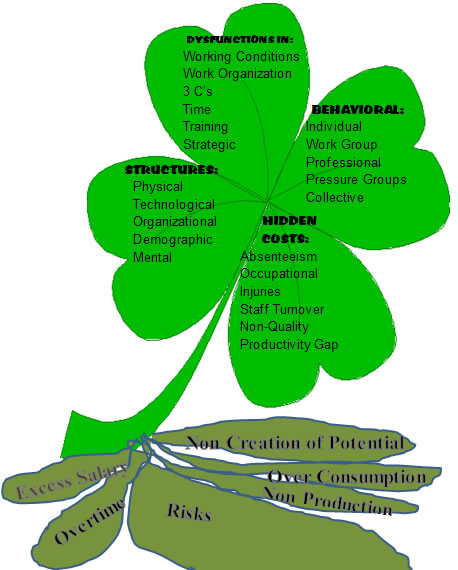
Figure 28 - Adapted from the 4-Leaf Clover (Diagnostic of Small Business Dysfunctions) (see p. 124 and p. 33 for stems, in Savall, Zardet, & Bonnet, 2008) book for the original version). Include 4-Leaf drawing in your mid-term and final report that your client will understand and appreciate.
Question 3: What is Storytelling Standpoint Methodology?
Short Answer: Storytelling Standpoint method is defined diagnosing the narratives of the past, living story webs of aliveness in the Present, and the four kinds of antenarrative bridges between them (linear, cyclical, spiral, & rhizomatic).
More detailed answer: It is defined as the (efficacy) force of your storytelling consulting. Is the small business stuck-in-the-narrative-past? Is it stuck-in-the-antenarrative-future? E.g. trying to be linear, when a different antenarrative future-shaping wave would resolve deficiencies and excess. We must look behind the veil, not just work with the symptoms of a problem. There are people unseen behind the curtain (Wizard of OZ). You have a standpoint and each person in the small business has a standpoint (stuck in the past, in Nowness living relationships, or stuck in the future). Storytelling standpoint comes from the storytelling expressions in your writing in your storytelling notebook, in the oral telling you do with the client, in class during your presentations, and in the changes in the storytelling that the small business does as a result: changes in their marketing, changes in their understanding of the Little Wow Moments of their past, changes in the living story web of relationships to stakeholders (Now), and changes in the antenarratives, shaping their future
Small business idyllic is “a grafting of life and its event to a place, a familiar territory with its nooks and crannies, its familiar mountains, valleys, fields, rivers, and forests, and one’s own home” (Bakhtin, 1981: 225). The small business idyllic includes the family-as-idyll (family small business), nature-as-idyll (ranching & farming and other outdoor small business), and aesthetic-as-idyll (artistic or crafts-based small business). In family business one’s spouse, parents, children, or other relatives may work in the business, in a sequence of generations.
The idyll of the Old Wild (South) West, the ranching and farming ways of New Mexico once occupied a very large place of significance. It is still a storytelling standpoint, a force to be reckoned with, in Las Cruces, in cities and towns across the state.
Question 4: List Aristotle's Four Causes, and give an example of each?
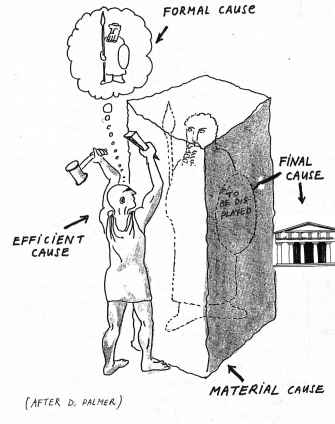
Figure 32 - Aristotle's 4 Causes
Out of what materialities has a organization come? |
Answer obtained by identifying: The Material Cause: |
e.g. The material cause points to the material constituents of the organization coming into Being-in-the-world.
2. What is its objective? |
Answer obtained by identifying: The Formal Cause: |
e.g. The formal cause embodies the model (drawing, or acrchetype) of the outcome, such as the idea or stratigic objective of the business or school as present in the head of the strategist or consultant.
3. By means of what is it? |
Answer obtained by identifying: The Efficient Cause: |
e.g. The efficient cause is the source of change (or rest) in the moving cause, such as the business owner working with the consultant, who makes the idea and makes the changes come to life by being an activator of change.
4. For the sake of what is it? |
Answer obtained by identifying: The Final Cause: |
e.g. the final cause is "that for the sake of which" (in-order-to) create the final shape. You start with potentiality, and move towards actualizing the actual upsurge spiral-antenarrative. The three D-P-I-E cycles are the activators of the final cause, the upsurge spiral. It coevolves in collaboraiton of consultant and client. It has movement activated (by efficient cause_, the the short-term activator (consultant) working with the client in the local neighborhood of stimulos (positive feedback amplification). The consulting projects are catalysis to activate change and amplifaction along the growing edge of the spiral, at time intervals (D-P-I-E cycles), each progressively more impactful than the former. This extends the spiral along material distrubution of four dimensions from Aristotle's "On the Soul":
Question 17: What are the four dimensions of Aristotle's "On the Soul" plus one the Quanta?
To Aristotles four aspects of Soul, let's add a fifth, the Quanta.
1. Qualia - the qualitative differences the spiral-antenarrative makes to the organizaiton
2. Substances - the materialities that are put to new use by finding untapped materiality and putting them to better value-added uses.
3. Potenia - This is final cause, where the potentials arrive from the future, and are actualized by acts of choice-making by consultant working with client.
4. Quantitative - there are quantiative indicators of movement.
PLUS A FIFTH
5. Quanta - Quanta is plural for quantum. Quantum has number and parts of magnitude. In quantum physics, quanta is the smallest amount of activating subatomic energy. The smallest subatomic particle has both wave an position. According to the Heisenberg Uncertainty Principle we can either measure the position of a partical (quanta) or its wave motion (quanta), but cannot measure them both at once. The quantum forces of the quantum-spiral-antenarrative have directionalities (inward and outward movement, upward and downward movement, centripetal and centrifugal movement) in waves. Quanta is a discrete quantity of wave energy proportional in magnitude to the frequency and amplitude of wavelenth in the movement of the spiral-antenarrative. .
A organization has material substance, quantities, qualia, potentia, and quanta, relations to place, relation to time of next seven generations, and to performance (peaks and valleys). Qualia is a tipping point between system and antisystem, between the heterogeneity of spaces, times, optics, material agencies, and pressures. To these four, I add the Quanta, the quantum forces of the soul of the spiral-antenarrative.
Question 5: What is the Heisenberg Uncertainty Principle and the Observer Effect?
According to the (Heisenberg, 1958) Uncertainty Principle we can either measure the position of a partical (quanta) or its wave motion (quanta), but cannot measure them both at once. The Heisenberg Uncertainty principlestates that the momentum and position of a particle cannot both be precisely determined at the same time.
"Consider, for example, the position x and the momentum p of a quantum particle such as an electron. The experimenter is free to measure either of these quantities to arbitrary precision, but they cannot possess precise values simultaneously" (Heisenberg, 1958, p. ix).
It is also known as the principle of indeterminancy. (ibid, p. 14)
Observer Effect: "The position of the electron will be known with an accuracy given by the wave length of the y-ray. The electron may have been practically at rest before the observation. But in the act of observation at least one light quantum of the y-ray must have passed the microscope and must first have been deflected by the electron" (ibid, p. 17).
The observer effect is not the same as Potenia: "It contains statements about possibilities or better tendencies ('potentia' in Aristotelian philosophy), and these statements are completely objective, they do not depend on any observer; and it contains statements about our knowledge of the system, which of course are subjective in so far as they may be different for different observers" (ibid, p.22 ).
The observer effect ahs to do with the measuring device: "The measuring device deserves this name only if it is in close contact with the rest of the world, if there is an interaction between the device and the observer" (ibid, p. 25).
As an observer of an organization, you having an effect on that organization. The simple ACT of writing down fieldnotes, interacts with the client, as they see you are paying attention noting what they say to you, their behavior changes, and they tell you things that would not tell you, if you were not writing verbatim fieldnotes. A causal chaion, hopefully an upsurge spiral-effect it set in motion by your notetaking.
In the Copenhagen interpretation, there is both uncertainty and observer effect (ibid, p. 90). You are developing a logbook of indicators to measure the organization's movement, which means you are about the momentum, not about the position (i.e. not measuring stages, or cycles of sameness, rather you are measuring the wave of movement of the spiral itself).
And, "processes in space and time, and it does not matter whether the observer is an apparatus or a human being; but the registration, i.e., the transition from the `possible' to the `actual, ' is absolutely necessary here and cannot be omitted from the interpretation of quantum theory" (p. 90).
In other words, by measuring spiral-antenarrative in space and time, you the consultant-observer register transitions from the possible to the actual, in quantum ways. Put those into your logbook (aka notebook of indicators, as you make your observations, and write verbatim fieldnotes).
Question 6. How to Turn a Hermeneutic Circle into a Hermeneutic Spiral?

Hermeneutics, is defined as an ongoing process of interpretation, such as how you observe and take notes about a client organization.
A hermeneutic circle, has recurring phases (or stages) in a cyclic-antenarrative process. The problem with this sort of interpretation is, the cycles of sameness, do not allow for the repitition of differences. So we need to move from hermeneutic circle (cycles) to the hermeneutic spiral.
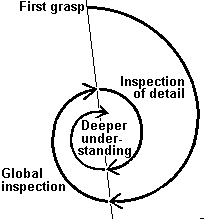
Here you see the now familiar, Hermeneutic Spiral in a seashell or in technical terms, a Logrithmic spiral. You observe at first grasp, then insepct detail, and n global inspection move to deeper understanding. The problem with this hermeneutic spiral, is that it is one-way flow, from periphery into the center (the technical word is centripetal).
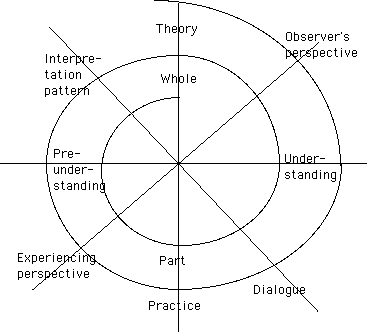
This is the Hermeneutic Siral of observation. It moves from the center to the periphery (centrfugal) from Alvesson & Sköldberg, 1994, p. 174) (source).
In the double spiral hermeneutic, there is also the forces of spiralness moving from periphery to outer orbits (the technical word is centrifugal).
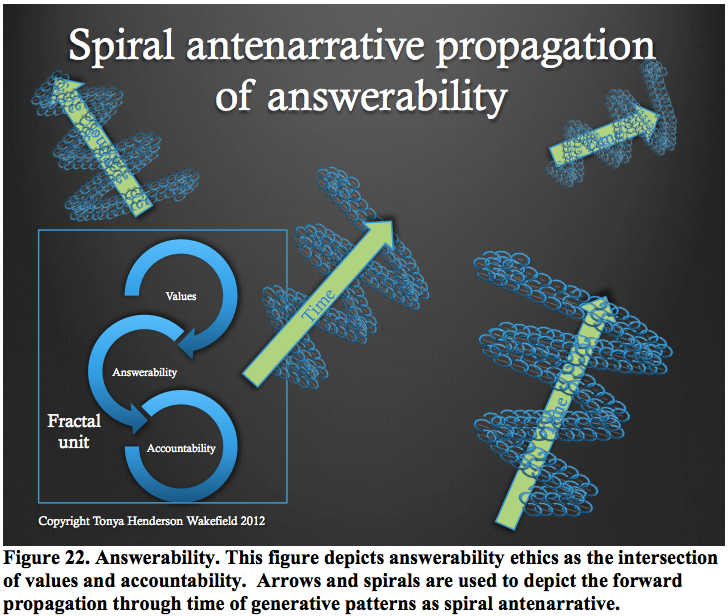
This is from Tonya Wakefield's dissertation on quantum fractal spirals in organizations. It builds on the Mandelbrot fractal spiral. The Wakefield (2012) dissertation applies the fractal spiral-antenarrative method to an analysis of a not-for-profit organization in Colorado. Answerability is an ethics term, meaning what is one's ethical answerability to intervene in an unfolding process, to make it better, to keep disaster from happening.

This Mandelbrot spiral fractal, has a repitiotn of off-shoot spirals along the main twirl axis. There is also a highly texturized interconnection between the orbits (trirls) . You get a sense of multispiral movements, the main spiral is a wave of several spiral, and along it are fractal off-shoots.
How do you turn a hermeneutic circle into a hermeneutic spiral? By activating the leading edges of amplification, and noting the fractal potentiality, turning the potentia into actuality. As you formulate a spiral hermeneutics in-the-field, you activate observer effects that deepen and chanelize the fractal-spiral-antenarrative, and its motion along a trajectory through an environment (with landscape, timescape, & performance). In this way the centripetal and centrifugal forces of double spiral-antenarrative have internal motion (upward and downward, centripetal and centrifugal), as well as the motion of traveling, moving through the enviornment. This occurs throug quanta activation (catalyst) that change the rules of the game. SUbstantive materialities are energizing the spiral processes. Poetentia is turning some set of futures into actualitiy.
To continue to doctoral level work, see Mgt 655 Systems Theory Course, on Quantum Hermeneutics.
Here is where by the Uncertainty Principle (see question below), you get MOVEMENT instead of just POSITION.
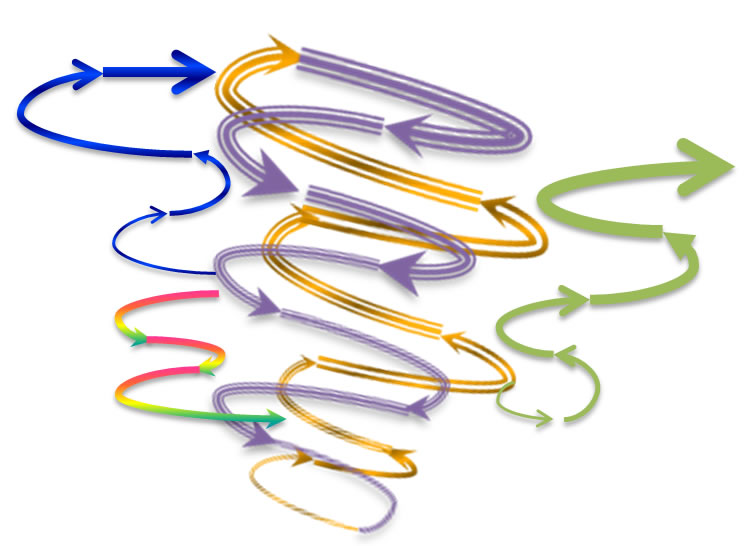
Figure 4 - A Q-Double-Spiral Model of the Processes of a organization with Bridges between Whorls, and a Fractal-spiral off-shoot (Drawing by D. Boje, July 18, 2012)
Spiral-antenarrative moves from a cyclic-antenarrative (a repeated cycle of same phases or stages done in the same way, again and again, without measured improvements) and moves into a spiral, where the orbits go into upsurge, an increase in quality, proudctivity, lowered cost, increased revenues.
Extended Answer: Note that the Q-Double-Spiral, has asymmetries. It is not a simplistic (naive) sort of spiral what has one-way flow around a solitary axis of rotation. The Q-spiral has offshoots (fractals), quantum leaps between the twirls (orbits), turning-points in the momentum. Q-Double-Spiral has embeddedness in multiple spirals (such as the green and cainbow offshoots).
It has two kinds of motion: the upward and doward motion within the spiral dyanamics, and the motion of movement across an environment that has at least three dimensions: Performance, Timescape, and Landscape. High peaks of performance net more revenue by being innovative. Lower peaks of performance have more competitors wallowing in the valleys. The Red Cross marks where the organization is now in its environment. The double spiral moves in timescape making a generating upward and downward curve along its leading edges, making small incremental moves (and some big quantum leaps).

Figure 4 - Above is a Tubular Spiral Seashell (Lamniconus) [source]. It has a multispiral conical shape as the outer cusp expands bysuccessive activation (catalysts) of substances forming the wave effect of growth in a reaction-diffusion process.
Please in your answer put in the 4 types of 'causality' in your answer.
Morin (2008: 60-1) looks at the problems inherent in the first three causalities, to which I will add a fourth:
- FIRST isLinear-antenarrative causality:
 “If with some raw material, applying some process of transformation, we produce some consumer object, we are in a frame of linear causality: z cause produces y effects” (p. 61). A good example of linear causal is PERT (Program Evaluation and Review Technique) for specifying the Critical Path (the longest time sequence).
“If with some raw material, applying some process of transformation, we produce some consumer object, we are in a frame of linear causality: z cause produces y effects” (p. 61). A good example of linear causal is PERT (Program Evaluation and Review Technique) for specifying the Critical Path (the longest time sequence). 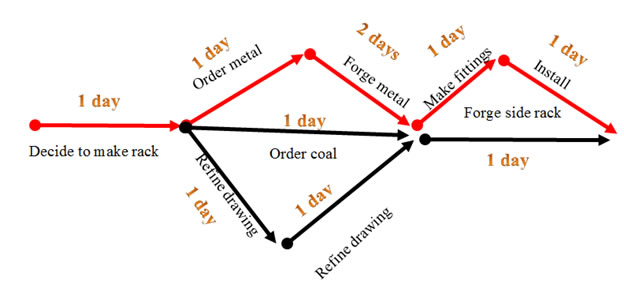
- Figure 6 - Building a Rack for my Harley-Davidson using blacksmithing forge process
- SECOND is Cyclic-antenarrative causality
 (feedback loop causality): “An enterprise needs to be regulated. It must carry out its production based on external needs, from the power of its work and its internal energy capacity. But we know – have known for about 40 years now, thanks to cybernetics – that the effect (sales or slumps) can feed back to stimulate or slow the production of objects and services in the enterprise” (p. 61).
(feedback loop causality): “An enterprise needs to be regulated. It must carry out its production based on external needs, from the power of its work and its internal energy capacity. But we know – have known for about 40 years now, thanks to cybernetics – that the effect (sales or slumps) can feed back to stimulate or slow the production of objects and services in the enterprise” (p. 61). - THIRD is Spiral-antenarrative causality
 (recursive causality): “In the recursive process, the effects and products are necessary to the process that creates them. The product is producer of that which produces it. … Society itself, as an organized and organizing whole, feeds back to produce the individuals through education, language, and school. The individuals, in their interactions, produce society, which produces the individuals that produce it. This creates a spiral circuit through historical evolution” (p. 61).
(recursive causality): “In the recursive process, the effects and products are necessary to the process that creates them. The product is producer of that which produces it. … Society itself, as an organized and organizing whole, feeds back to produce the individuals through education, language, and school. The individuals, in their interactions, produce society, which produces the individuals that produce it. This creates a spiral circuit through historical evolution” (p. 61). - FOURTH is Rhizomatic-antenarrative causality, (aka Assemblage or network causality)
 (relational/mutual and recursive): cause and effects are in an assemblage network, or ‘rhizome’ of relationships, in a repetition of difference that deterritorializes and reterritorializes the landscape (see Deleuze & Guattari, 1987). Here is an example of rhizome-causality from SEAM consultuing.
(relational/mutual and recursive): cause and effects are in an assemblage network, or ‘rhizome’ of relationships, in a repetition of difference that deterritorializes and reterritorializes the landscape (see Deleuze & Guattari, 1987). Here is an example of rhizome-causality from SEAM consultuing. 
- Figure 14 - The 4-Leaf Clover with 6 below ground Tubers (aka root-stems).
- The tubers (root-stems) below ground of the 4-leaf clover (which is a rhizome).
- In rhizomatic (relational) causality, “This relational type of causality involves recognizing that an effect is caused by the relationship, often one of balance or imbalance, between elements of a system. Neither element is the cause by itself” (Harvard Graduate School of Education, 2008: 6). http://www.cfa.harvard.edu/smg/Website/UCP/causal/causal_types.html This means in the SEAM consulting, we encounter below ground tubers that are effecting the surface dysfunctions found in the 4 leaves of the clover. Until deep roots are changes, the surface dysfunctions keep happing.
(1) TYPE 1: The linear antenarratives link living story to narrative, by narrative taking one plot from a rich diversity of living stories, and leaving the others behind in-order--to construct one linear-plot. Many small businesses are stuck-in-the-past narrative, and rolling it over into a linear antenarrative of their future strategic plans, and they keep replicating the linear path. The proble with being stuck-in-the-past is one misses the whole set of living stories emerging in the Present, that define new future strategic paths. It is a rut! That narrative-past fiction that takes one plot of one living story, then reincarnats it into linear antenarrative dissolves in the Time Spiral, creates teh deeply rooted tubers, and a four-leaf SEAM clover (a flower) opens into many dysfunctions.
(2) TYPE 2: The cyclic antenarrative. Examples are cycle times, life cycles of products and organizations, cash-to-cash cycles, inventory turn cycles, etc. There are many recurring small business cycles, especially in seasonal natural cycle, Aggie-businesses in farms and ranch, for example, the harvesting and herding cycles. The cycles have stages that allow you to predict what will happen in the subsequent stage. Many times, these small business cycles become spirals because the cycle does not repeat exactly each time, into the future. As the whorl amplifies or contracts, it is more accurately a, spiral of some sort.
Can you as a consultant help a client move out of linear- and cyclic-antenarrative ruts into a Q-spiral-antenarrative understanding?
4. TYPE 4: Rhizome-antenarratives - This is the 4th type of antenarrative linear, cyclic, and spiral are the others). There are plant and more thing assemblages. You have assemblage happening all around you, and oftentimes do not notice it at all!
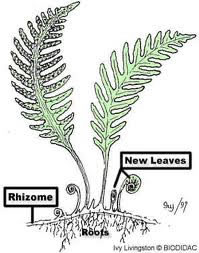
Figure 17 Assemblage (rhizome) antenarrative
You have assemblages (clothes, stuff in purses and wallets, things spread about your desk). The small business has its assemblages, and each thing has a history, and an ante (a bet) and a different ante (a before future is all known). Each thing is an 'actant' a non-human, non-animal actant in the unfolding, moving, changing assemblage. Each thing is 'vibrant matter' (Bennett, 2010). There are roots (above ground) and roots (below ground) in a plant-rhizome. Vibrant materiality assemblages are all about us.